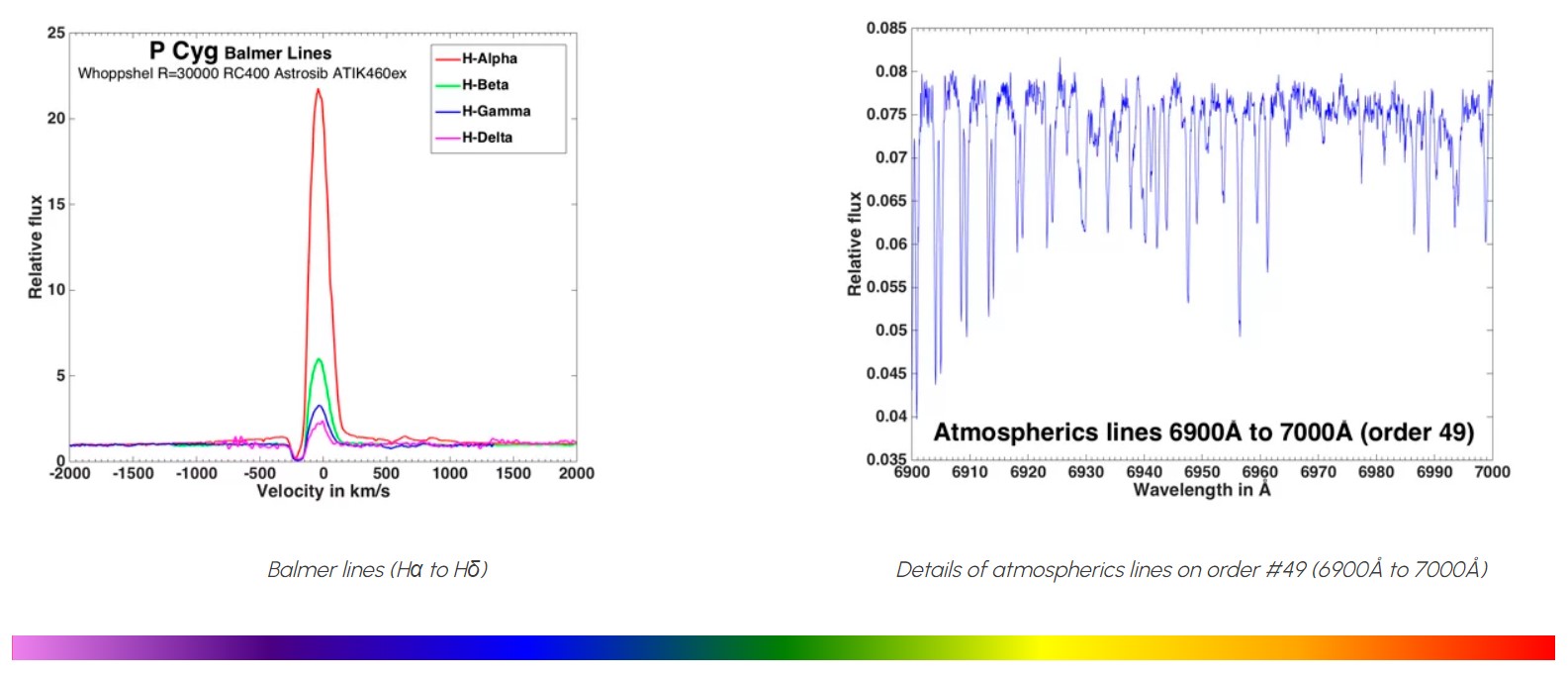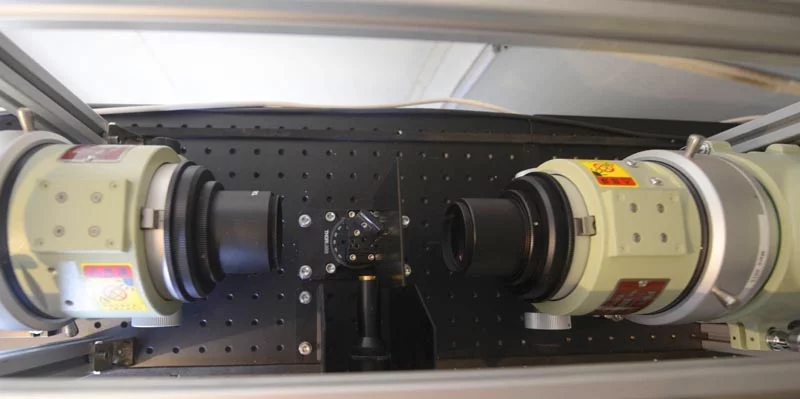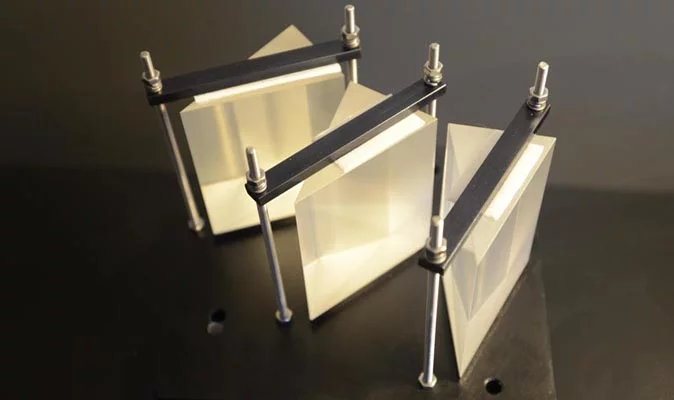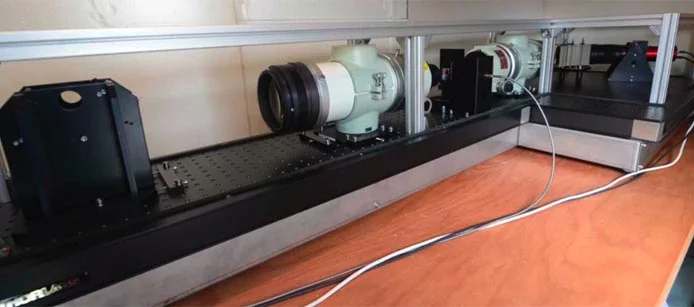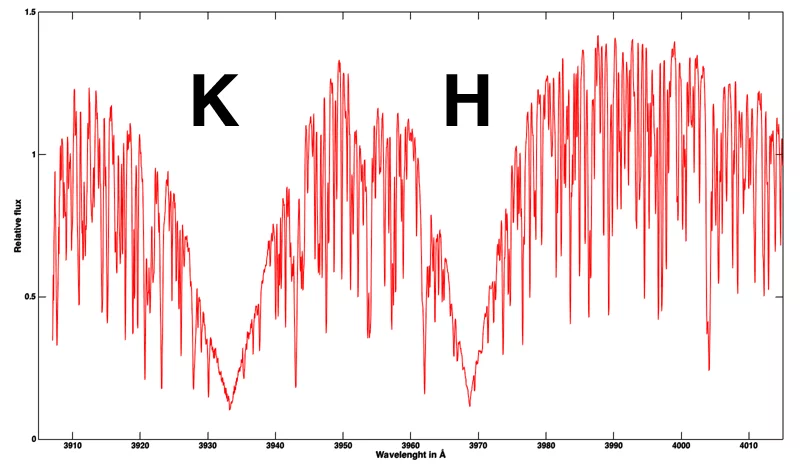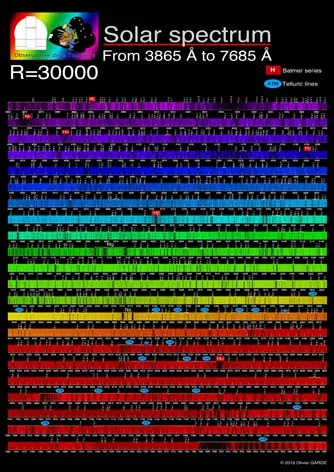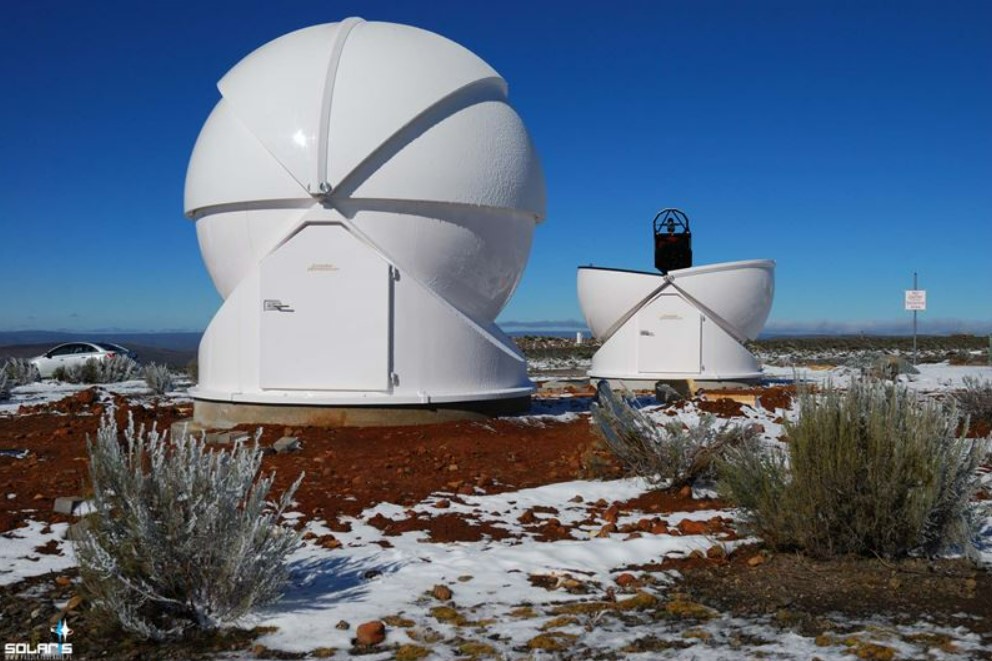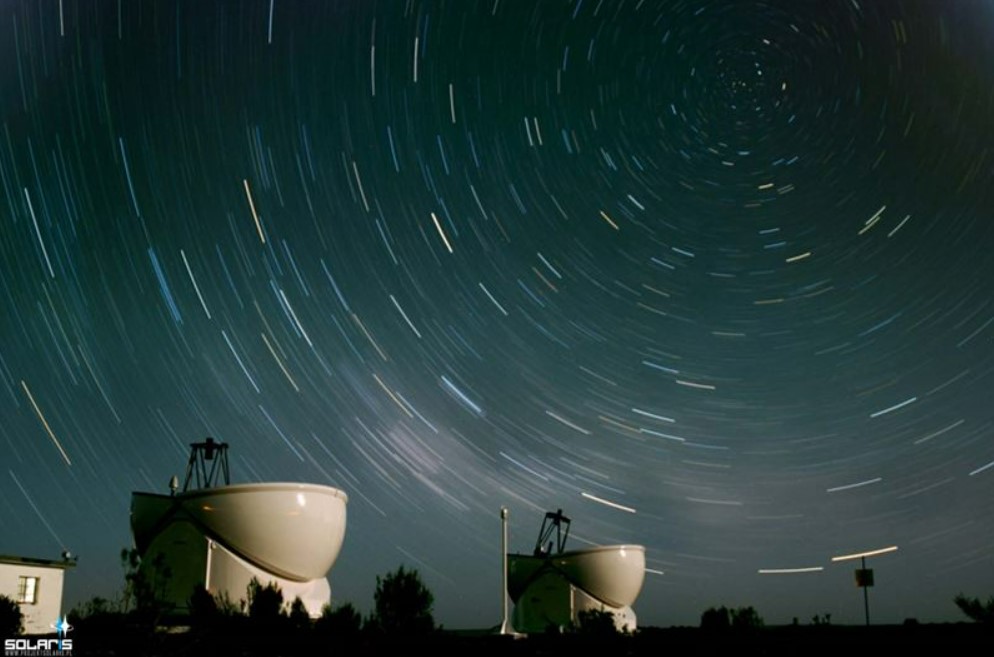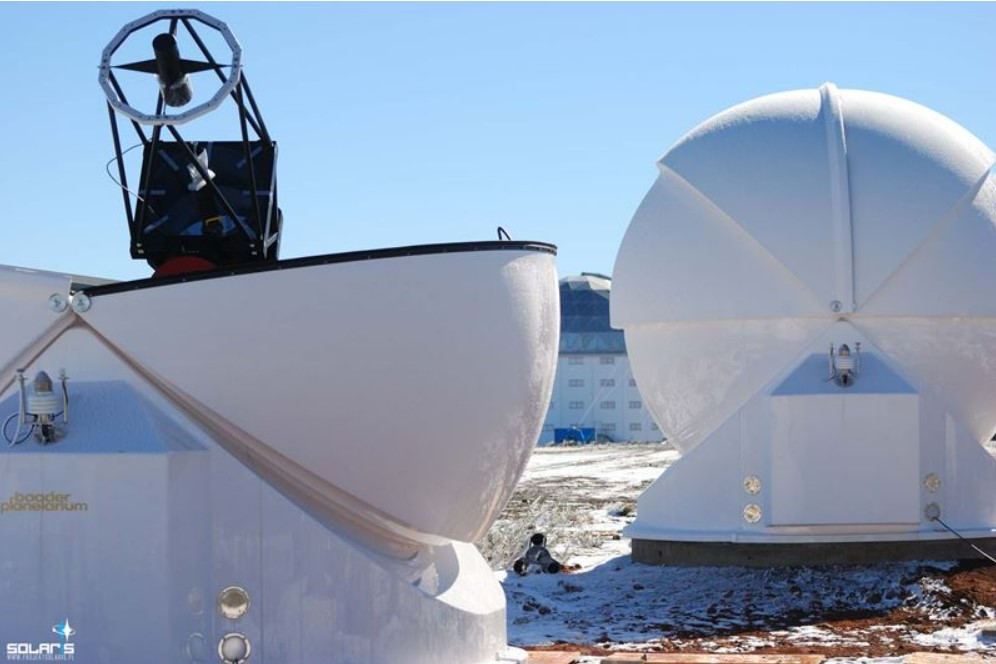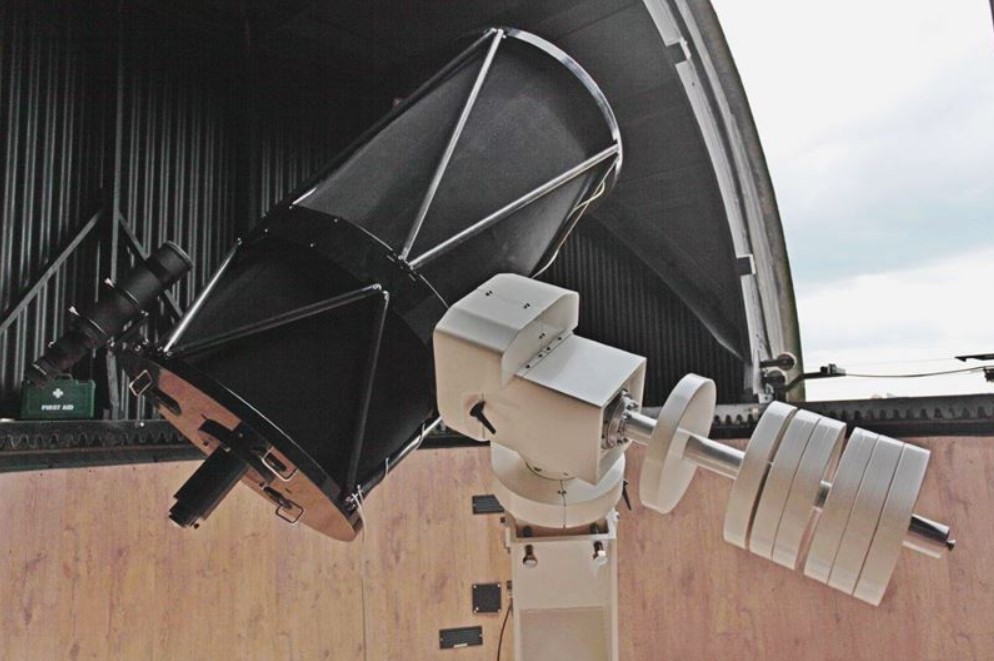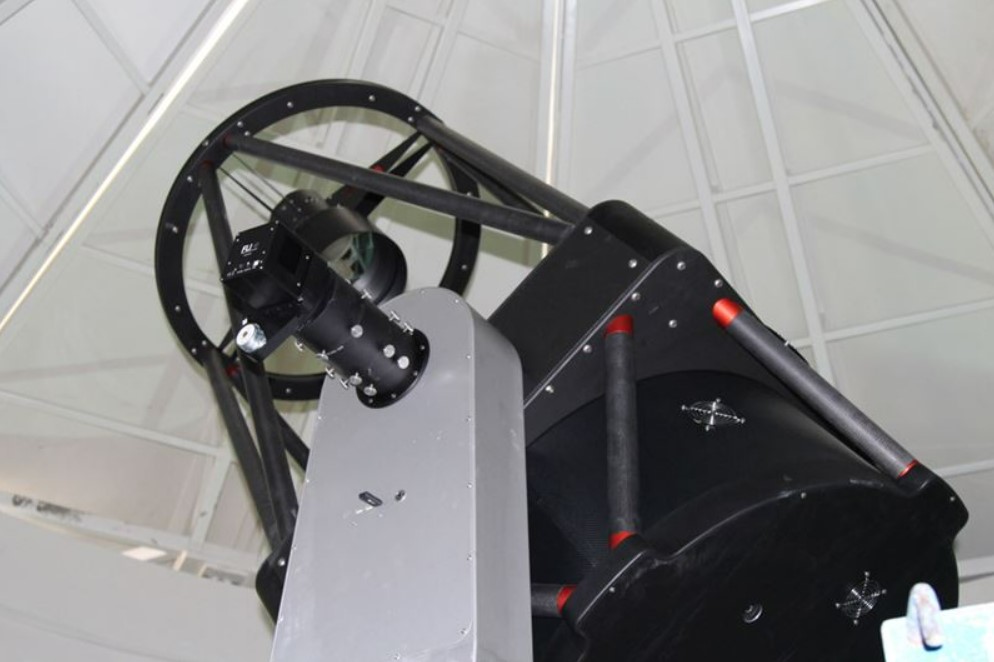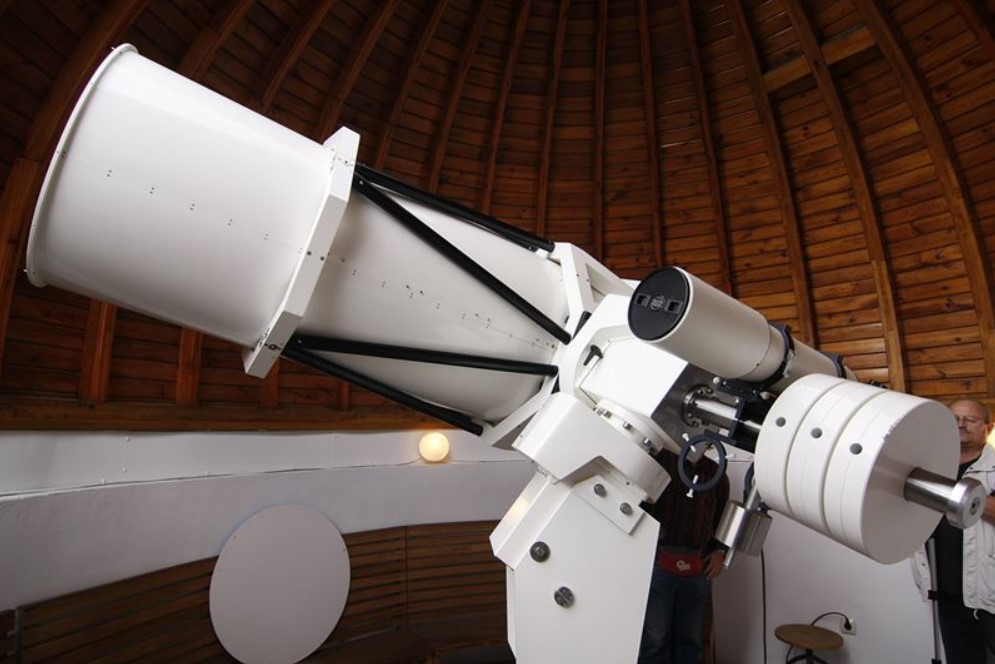By Olivier Garde
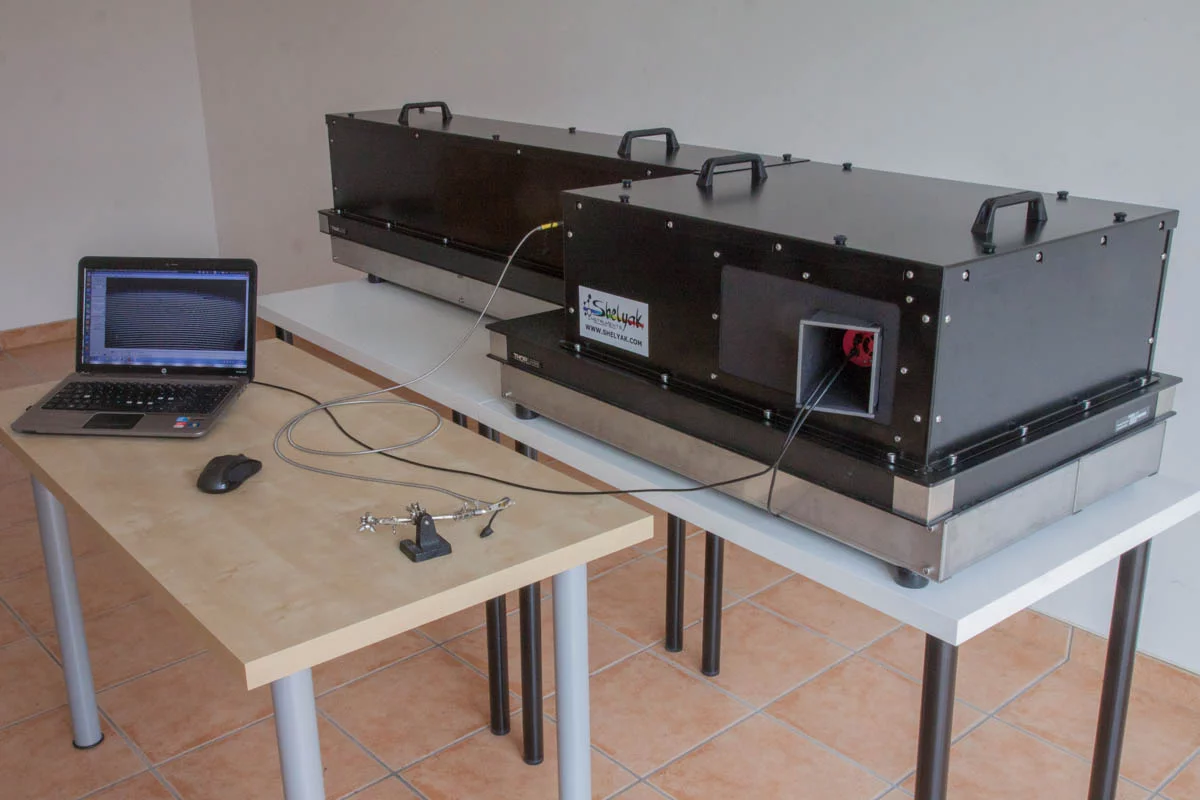
The Whoppshel was born from the demand of our customers to have a higher resolution echelle spectroscope than the eShel for telescopes of one meter class. The whoppshel, with a resolution R = 30000, is particularly adapted to radial velocity measurements.
|
The two FSQ-106 refractor |
The three prisms composing the cross-disperser |
In the foreground on the left the main grating |
Whoppshel is based on a few principles:
-
An optical White Pupil architecture, which allows to naturally compensate for certain optical aberrations (passing twice symmetrically in the optical components), and on the other hand to maintain a reasonable target size.
-
The use of Takahashi lens (FSQ106 at F/ 3.6) for the collimator and a high-end photo lens (Canon 135mm F/2) for the objective lens. All the high constraints on the optics are thus embedded in high quality elements manufactured in series.
-
The instrument is assembled on an extremely rigid optical bench.
The cross-disperser of the echelle spectrum is obtained using three prisms specially made for this spectrograph.
Optical path of Whoppshel
Like eShel, Whoppshel is a fiber optic spectrograph. It uses the same injection fiber module, the same optical fibers and the same calibration box as the eShel range.
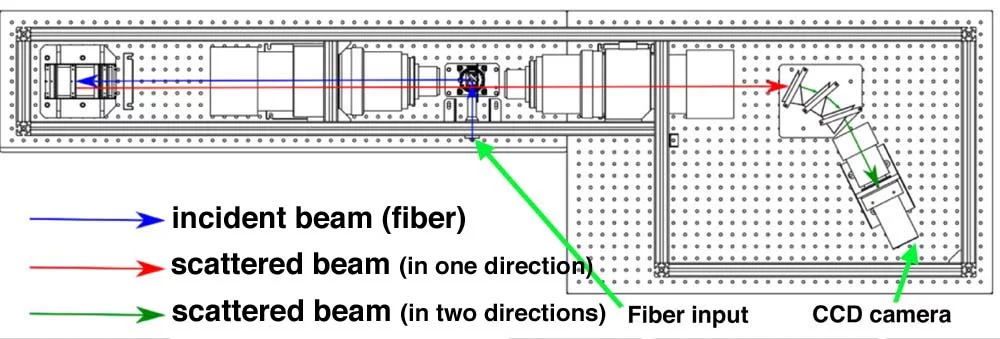
Schematic Whoppshel diagram
The light collected by the telescope is injected via the 50μm optical fiber in the middle of the two Takahashi lens, a small mirror deviates the beam towards the first telescope. The beam is then spread out by the echelle grating. It is then returned to the two symmetrically mounted lens, which eliminates most of their residual aberrations. The output converges to the three prisms (cross-disperser) which separate the different orders. The 135mm photo lens open at f/2 finally retrieves the sprectrum signal in both axes to focus the spectrum on the CCD sensor of the camera.
Specifications
The Whoppshel has a resolving power of approximately R = 30000 (slightly variable according to the orders) and covers a wavelength range from 3900 Å to 7600Å.
This spectrograph has a length of 2.10m and measures 0.6m in its greatest width. It is installed on 2 optical benches, 0.9×0.6m and 1.2m x 0.3m assembled very rigidly together. The total mass of the spectrograph is 81 kg.
A Bosch profile structure (standard elements) allows the entire enclosure of the instrument to be protected from stray lights and dust.
For the spectral calibration performed with Whoppshel, the same calibration unit as the one dedicated to eShel is used. This calibration unit includes a Halogen lamp to generate flats and a Thorium / Argon spectral lamp with a very large number of lines distributed over all orders of the spectrograph. The calibration unit can be controlled remotely via an RS 232 interface.
Here’s a spectrum of the Th/Ar lamp use for wavelength calibration :
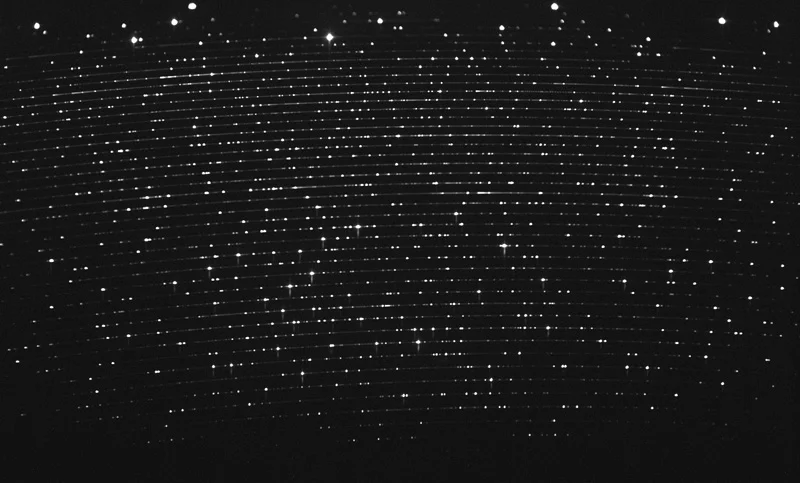
To inject the light flux coming from the telescope, the Whoppshel uses the same injection and guiding module as the eShel spectrograph according to the f / d ratio of the telescope:
• For telescopes open at f / d 6: FIGU F/6 – 50µm
• For telescopes open at f / d 9: FIGU F/9 – 50µm
It is therefore necessary that the telescope approaches the f / d ratios above for maximum efficiency.
Of course, we need to add to the setup, a 50µm object fiber for object, a optical fiber 200µm for calibration, and a guiding camera.
A 105μm optical fiber can also be used to take lower magnitude target, in which case the resolution of the Whoppshel will be about R = 15000.
Additional modules: technical specifications
| Description | Shelyak ref. | Acc. type | Included | Comment |
| FIGU F/6 50μm | PF0008 | Guiding module | Bonnette STANDARD | |
| FIGU F/7.8 50μm | PF0066 | Guiding module | ||
| FIGU F/9 50μm | PF0018 | Guiding module | ||
| FIGU F/7 50μm | PF0067 | Guiding module | ||
| FIGU F/6 105μm | PF0068 | Guiding module | ||
| FIGU F/9 105μm | PF0069 | Guiding module | ||
| FIGU F/7.8 105μm | PF0070 | Guiding module | ||
| FIGU F/7 105μm | PF0071 | Guiding module | Includes ThAr lamp, and flat (Tungsten & LEDs) | |
| eShel calibration module | PF0012 | Calibration module |
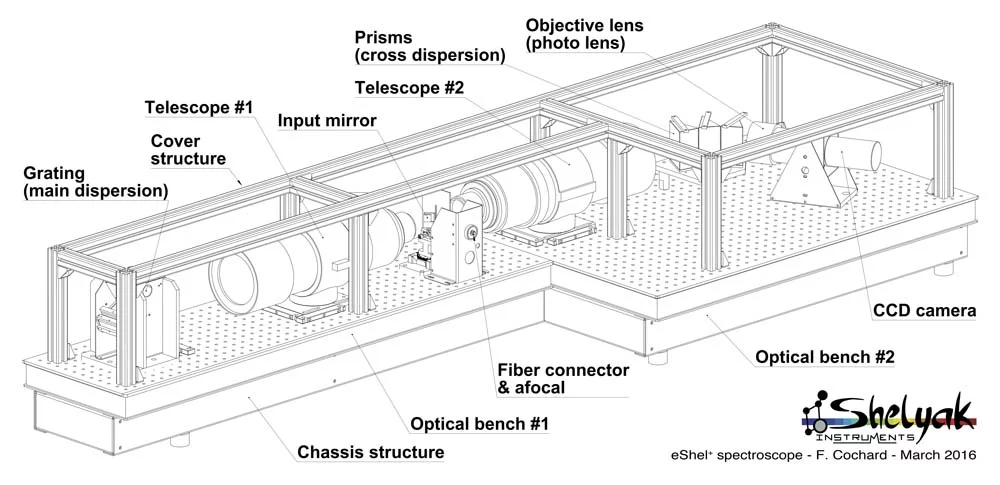
Delivery and assembly of the spectroscope
The Whoppshel is delivered in spare parts because of its dimensions (Shelyak can of course install and adjust the Whoppshel for you if necessary). An assembly instructions allows the entire spectroscope to be assembled step by step.
Since the instrument is installed on an optical bench, the installation is done by following the beam of light element by element – editing is an extremely educational exercise, particularly useful for students.
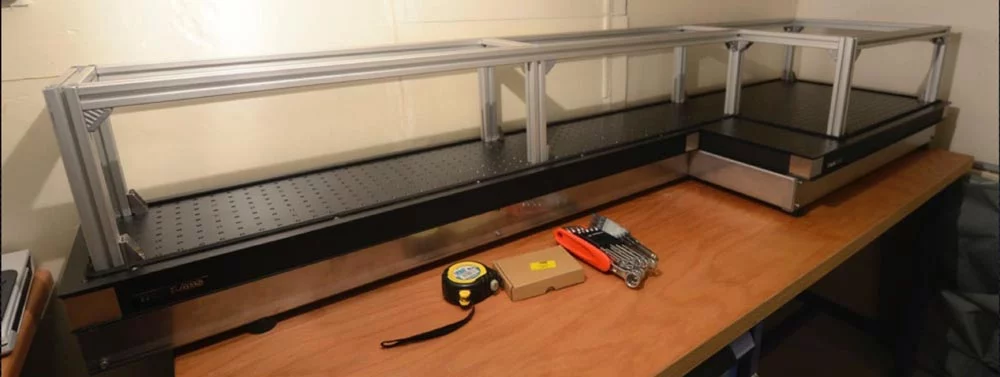
It takes about 2 days to assemble and tune the Whoopshel.
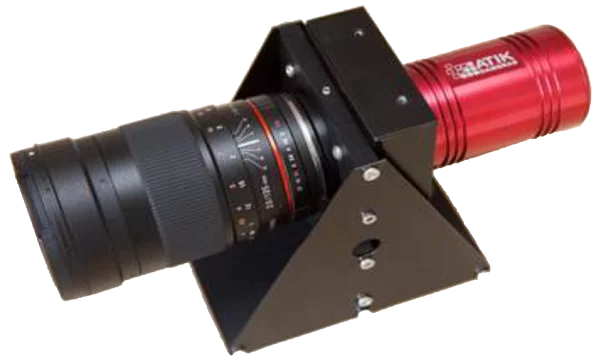
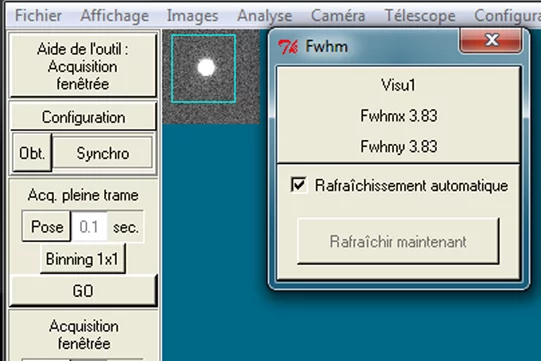
The CCD camera on its support and its optics FWHM Measurement of the spot with Audelà software
The CCD camera is mounted on its holder with its 135mm optics, it will be used during all stages of the assembling to tune the focus and alignment of each optical element. This operation is greatly facilitated by the fact that all light streams are at the same height and centered on the camera. Thanks to the AudeLA software, we can measure the FWHM of the spot after each optical element.
The ATIK 460ex CCD camera is particularly recommended for this spectrograph because of the width of its sensor, its quantum efficiency and the read noise about 5e-. Other CCD cameras can of course be used, just check that the sensor can cover all the orders of the spectrograph and also that orders can overlap from one order to another. At a minimum, the ATIK 460ex meets these criteria. If you want to use another camera, you have to take into account the distance between the optical axis of the CCD and the optical bench which is 102mm.
First try : The Sun light
Without waiting for the night, we can make a first test of the spectrograph by using the day light directly on the optical fiber placed outside. Here is the first raw spectrum obtained:
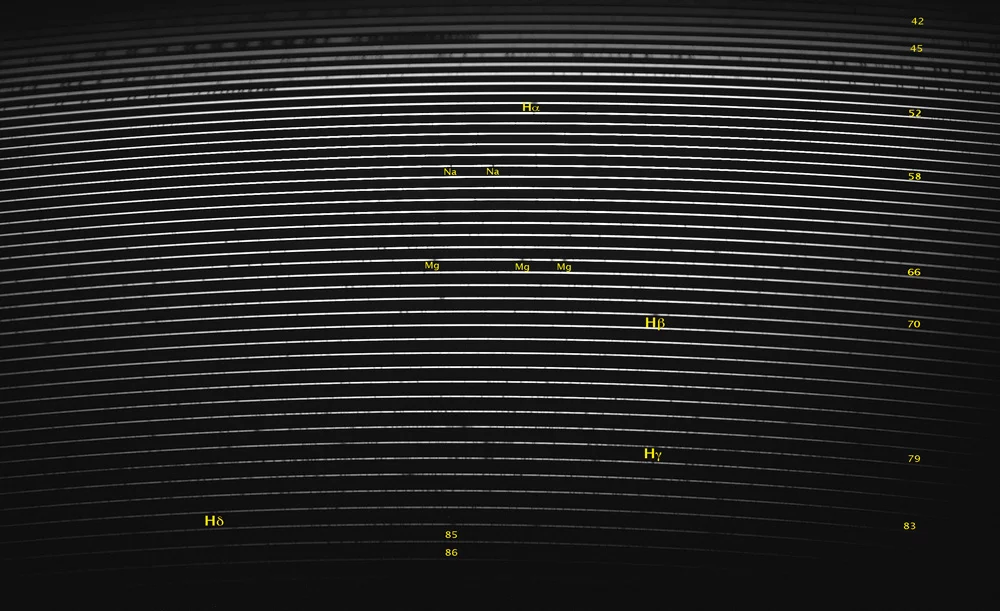
In this raw image, we have identified some lines of the solar light, such as Balmer lines (Hα, Hβ, Hγ, Hδ), the Sodium doublet (D1, D2) and the magnesium triplet.
The orders identified are from 42 to 87, the latter containing the lines H and K of the calcium.
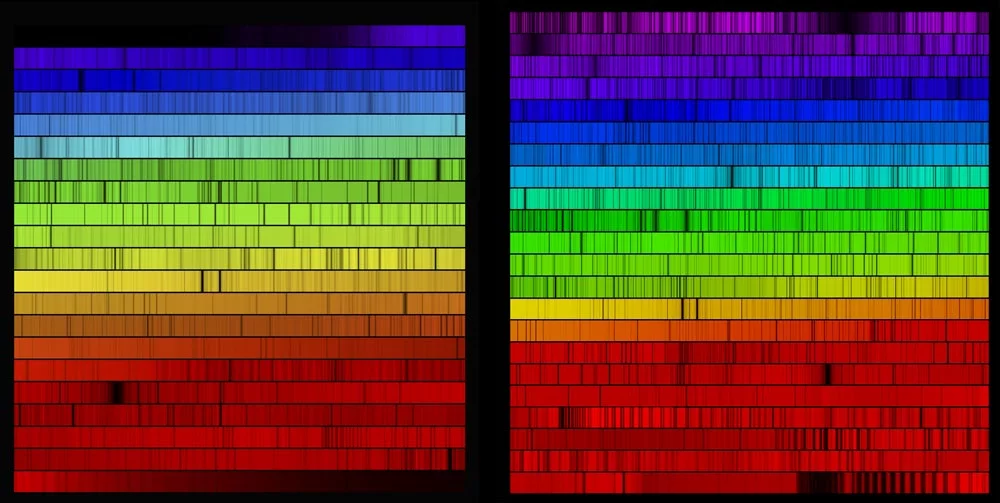
LHIRES III R=18000 Woppshel R=30000
H and K lines from the Sun at 3968,47 Å and 3933,68 Å
First stellar observations
First light on Be star Zet Tau (mag. V=3,03) with a Richtey-Chretien telescope of 400mm diameter : 3 exposures of 300s with an ATIK 460ex CCD use in bin 1×1 mode.
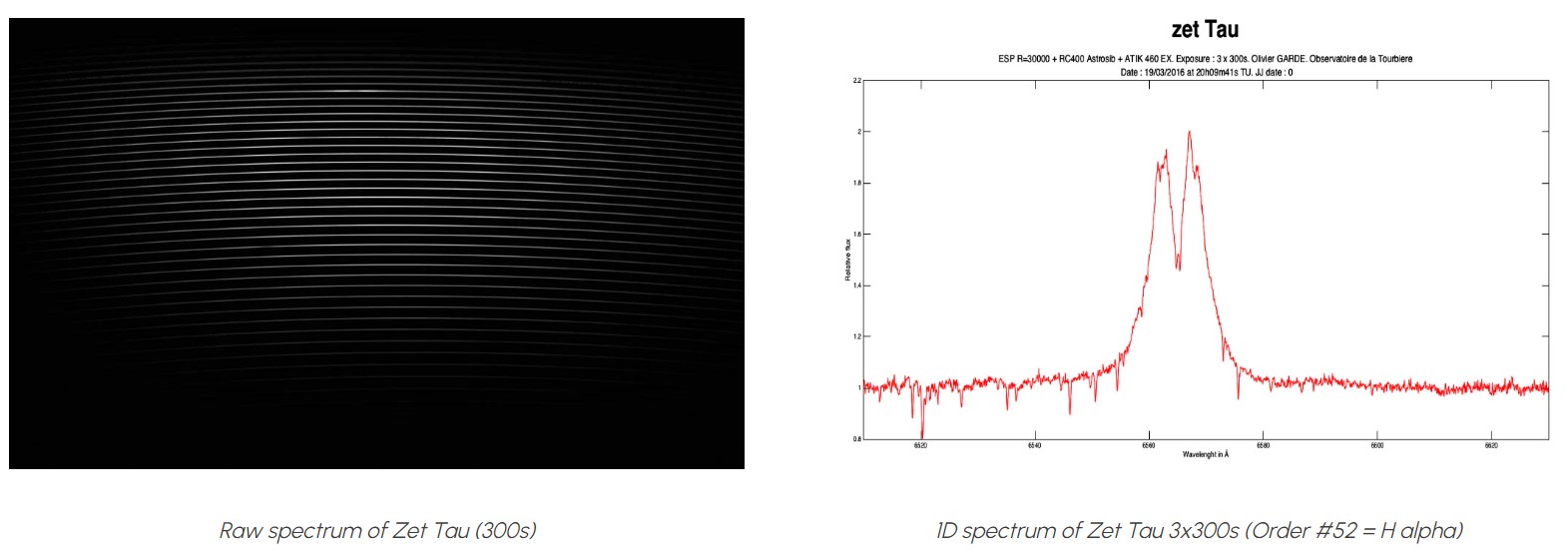

Above, another test with the star Eta Tau, mag. V = 2.87 with the same telescope of 400mm diameter and the comparison with the spectrograph eShel R = 11000 (curve in blue). We can be seen that Whoppshel solves the telluric lines present around the H Alpha line better than the Eshel spectrograph.
Finally, an observation of P Cyg, mag. V = 4.82, still with the same telescope of 400mm of diameter.
22 exposures of 300 seconds.
